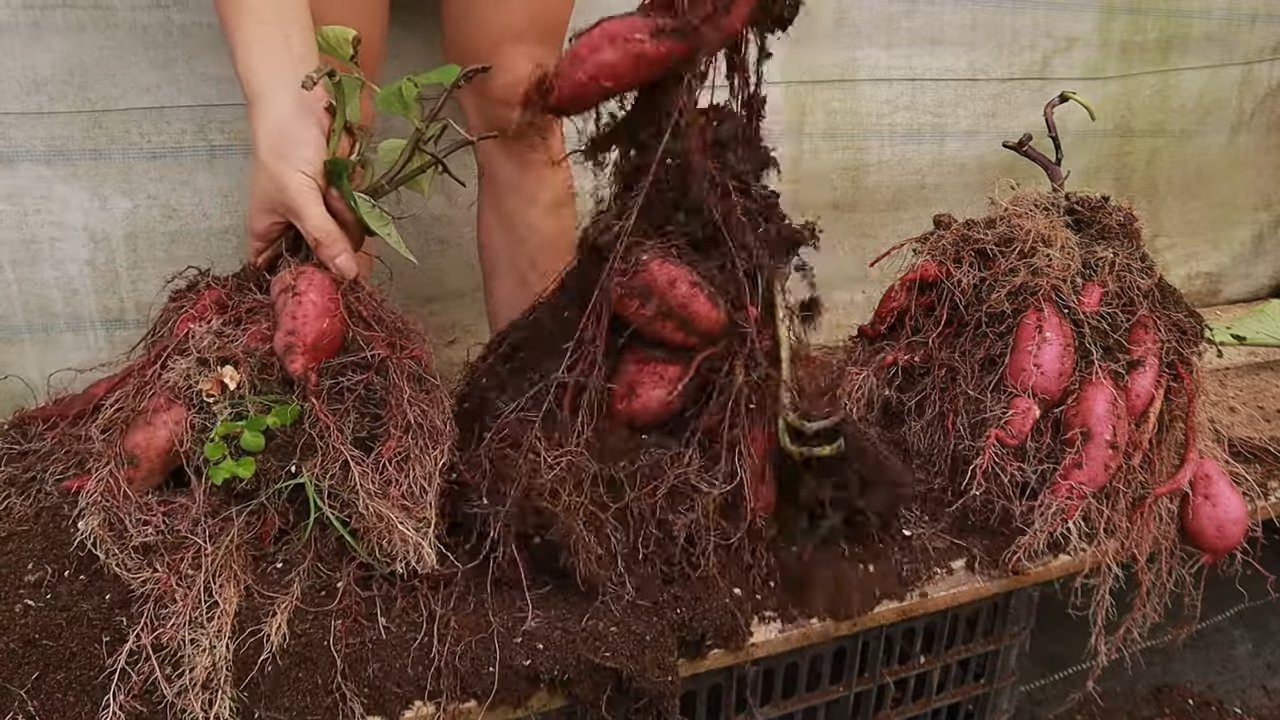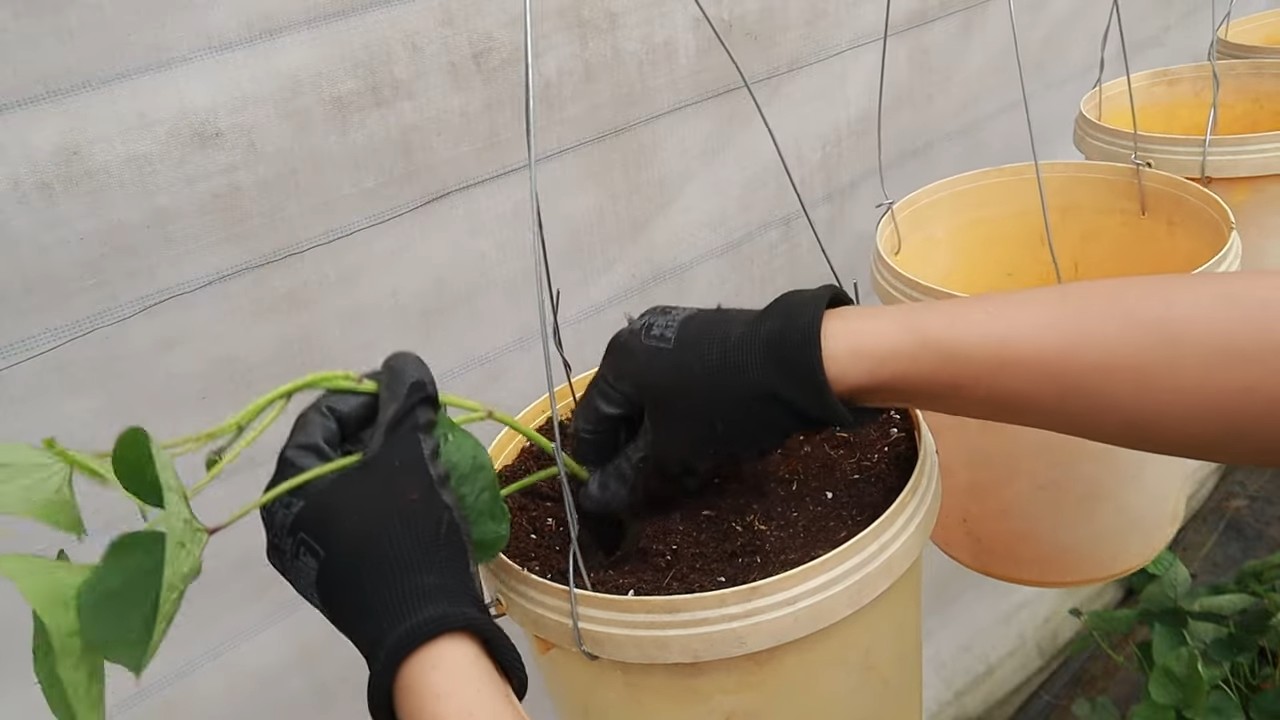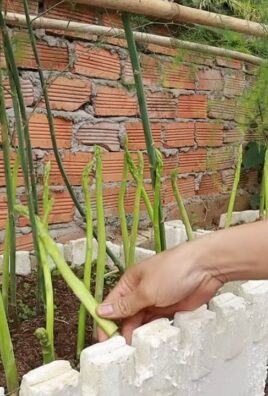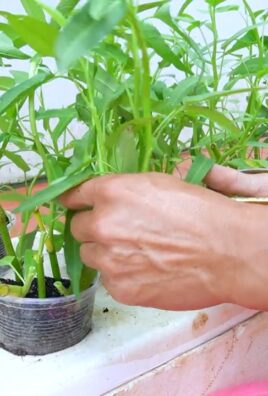Hanging sweet potato growing: Ever dreamt of a lush, cascading curtain of vibrant green vines adorned with the promise of delicious, homegrown sweet potatoes? Forget sprawling garden beds – we’re taking this root vegetable to new heights! This isn’t just about growing food; it’s about creating a stunning visual masterpiece right in your own backyard (or balcony!).
For centuries, sweet potatoes have been a staple in diets around the globe, revered not only for their nutritional value but also for their resilience and adaptability. From their origins in Central and South America, they’ve journeyed across continents, becoming a symbol of sustenance and resourcefulness. Now, we’re adding a modern twist to this ancient crop!
Why should you embrace the art of hanging sweet potato growing? Well, for starters, it’s a fantastic solution for those with limited space. Apartment dwellers, rejoice! But beyond space-saving, it’s also a brilliant way to deter pests, improve air circulation, and add a unique, eye-catching element to your outdoor décor. Plus, let’s be honest, who wouldn’t want to impress their friends and neighbors with a gravity-defying display of edible beauty? I’m excited to share my favorite DIY tricks and hacks that will have you harvesting sweet potatoes from hanging baskets in no time. Let’s get started!

DIY Hanging Sweet Potato Vine: A Beautiful and Edible Decoration
Hey there, fellow plant enthusiasts! I’m so excited to share this super fun and rewarding DIY project with you: growing sweet potato vines in hanging baskets. Not only are they incredibly easy to care for, but they also add a touch of whimsical beauty to any space. Plus, you might even get a few sweet potatoes at the end of the season! Let’s dive in!
What You’ll Need
Before we get started, let’s gather all the necessary supplies. This will make the whole process smoother and more enjoyable.
* Sweet Potatoes: Choose organic sweet potatoes if you plan to eat the potatoes or sprouts later. You can use any variety you like – Beauregard, Garnet, Japanese, whatever catches your eye! I personally love the vibrant purple skin of Japanese sweet potatoes.
* Hanging Baskets: You’ll need hanging baskets with good drainage. Coco coir liners are great, but any basket that allows excess water to escape will work. Size depends on how many sweet potatoes you want to grow in each basket. I usually go for 12-14 inch baskets.
* Potting Mix: Use a high-quality, well-draining potting mix. Avoid using garden soil, as it can compact and hinder root growth. I prefer a mix that includes peat moss, perlite, and vermiculite.
* Toothpicks: These are crucial for suspending the sweet potato in water.
* Water: Tap water is fine, but letting it sit out for a day or two allows chlorine to dissipate, which is beneficial for the plants.
* Optional: Rooting Hormone: While not essential, rooting hormone can speed up the sprouting process.
* Optional: Fertilizer: A balanced liquid fertilizer can help your vines thrive once they’re established.
Sprouting Your Sweet Potatoes
This is the first and arguably most exciting part! Watching those little sprouts emerge is so rewarding.
1. Prepare the Sweet Potato: Gently wash your sweet potato to remove any dirt.
2. Insert Toothpicks: Insert 3-4 toothpicks evenly spaced around the middle of the sweet potato. These will act as supports to suspend it in water.
3. Submerge in Water: Place the sweet potato in a jar or glass, pointy end down, with the bottom half submerged in water. Make sure the water level stays consistent.
4. Find a Sunny Spot: Place the jar in a warm, sunny location. A windowsill is perfect.
5. Wait and Watch: Be patient! It can take anywhere from a few days to a few weeks for sprouts to appear. Change the water every few days to prevent algae growth.
6. Optional: Rooting Hormone: If you’re using rooting hormone, dip the bottom of the sweet potato in it before placing it in water.
Planting Your Sprouted Sweet Potatoes
Once your sweet potatoes have developed healthy sprouts and roots (about 4-6 inches long), it’s time to plant them in the hanging baskets.
1. Prepare the Hanging Basket: Line your hanging basket with a coco coir liner (if it doesn’t already have one).
2. Fill with Potting Mix: Fill the basket with your well-draining potting mix, leaving about an inch or two of space at the top.
3. Gently Remove Sprouts: Carefully remove the sprouted sweet potatoes from the water. You can either plant the entire sweet potato or gently twist off the individual sprouts (called “slips”) and plant those. Planting the slips will result in more vines, but planting the whole potato is easier.
4. Plant the Sweet Potatoes or Slips: If planting the whole sweet potato, bury it halfway in the potting mix, making sure the sprouts are facing upwards. If planting slips, dig small holes and gently place the roots in the holes, covering them with soil. Space the slips a few inches apart.
5. Water Thoroughly: Water the newly planted sweet potatoes thoroughly until water drains out of the bottom of the basket.
Caring for Your Hanging Sweet Potato Vines
Now that your sweet potato vines are planted, it’s time to provide them with the care they need to thrive.
1. Sunlight: Sweet potato vines love sunlight! Place your hanging baskets in a location that receives at least 6 hours of direct sunlight per day.
2. Watering: Water regularly, especially during hot weather. The soil should be consistently moist, but not soggy. Check the soil moisture by sticking your finger into the soil – if it feels dry an inch or two down, it’s time to water.
3. Fertilizing: Feed your sweet potato vines with a balanced liquid fertilizer every 2-3 weeks during the growing season. Follow the instructions on the fertilizer package.
4. Pruning: Prune your vines regularly to encourage bushier growth and prevent them from becoming too leggy. Simply snip off the ends of the vines with clean pruning shears. You can also trim any yellowing or damaged leaves.
5. Pest Control: Keep an eye out for pests like aphids and spider mites. If you notice any infestations, treat them with insecticidal soap or neem oil.
6. Support: As the vines grow longer, you may need to provide them with some support. You can use trellises, stakes, or even let them trail down from the hanging basket.
Harvesting (Optional)
While the main purpose of growing sweet potato vines in hanging baskets is for their ornamental value, you can also harvest the sweet potatoes if you wish.
1. Timing: Sweet potatoes are typically ready to harvest in the fall, after the vines have started to die back.
2. Harvesting: Gently dig around the base of the plant and carefully lift the sweet potatoes out of the soil. Be careful not to damage the potatoes.
3. Curing: Cure the sweet potatoes for 1-2 weeks in a warm, dry place. This will help them develop their sweetness and improve their storage life.
4. Storage: Store cured sweet potatoes in a cool, dark, and dry place.
Troubleshooting
Even with the best care, you might encounter a few challenges along the way. Here are some common problems and how to address them:
* Yellowing Leaves: This could be a sign of overwatering, underwatering, nutrient deficiency, or pest infestation. Check the soil moisture, fertilize if necessary, and inspect for pests.
* Leggy Growth: This is usually caused by insufficient sunlight. Move your hanging baskets to a sunnier location.
* No Sprouts: If your sweet potato isn’t sprouting, make sure it’s in a warm, sunny location and that the water level is consistent. You can also try using a different sweet potato.
* Slow Growth: This could be due to poor soil, insufficient sunlight, or lack of nutrients. Amend the soil with compost, move the baskets to a sunnier location, and fertilize regularly.
Creative Ideas and Variations
Here are a few ideas to personalize your hanging sweet potato vine project:
* Mix and Match Varieties: Plant different varieties of sweet potatoes in the same basket for a colorful and textured display.
* Add Companion Plants: Plant other trailing plants like petunias, verbena, or calibrachoa in the same basket for added visual interest.
* Use Different Containers: Get creative with your containers! Use old buckets, baskets, or even repurposed tires.
* Grow Indoors: Sweet potato vines can also be grown indoors, provided they receive enough sunlight.
* Edible Leaves: Did you know that sweet potato leaves are edible? You can harvest them and use them in salads, stir-fries, or soups. Just make sure they haven’t been treated with any pesticides.
Enjoy Your Beautiful Hanging Sweet Potato Vines!
I hope you found this guide helpful. Growing sweet potato vines in hanging baskets is a fun and rewarding project that will add beauty and a touch of whimsy to your home. Happy gardening!

Conclusion
So, there you have it! Transforming a humble sweet potato into a stunning, cascading vine is not only surprisingly simple, but also incredibly rewarding. This DIY hanging sweet potato growing project offers a unique blend of beauty and practicality. Forget those expensive, store-bought hanging baskets – with just a sweet potato, some water, and a little patience, you can create a living masterpiece that will brighten up any space.
Why is this a must-try? Because it’s more than just a plant; it’s an experience. It’s a chance to connect with nature, to witness the miracle of growth firsthand, and to add a touch of whimsical charm to your home. It’s also a fantastic conversation starter! Imagine the delight of your guests when they see your vibrant sweet potato vine gracefully spilling from its container.
But the benefits don’t stop there. Beyond its aesthetic appeal, a hanging sweet potato vine also acts as a natural air purifier, helping to create a healthier and more inviting environment. Plus, you have the option of eventually harvesting the sweet potato itself, although focusing on the foliage is generally recommended for hanging displays.
Ready to take your hanging sweet potato growing to the next level? Consider these variations:
* **Different Sweet Potato Varieties:** Experiment with different varieties of sweet potatoes to see which ones produce the most vibrant foliage. Some varieties have purple or bronze leaves, adding even more visual interest.
* **Creative Containers:** Don’t limit yourself to traditional hanging baskets. Get creative with your containers! Use repurposed buckets, woven baskets, or even old colanders to add a unique touch to your display. Just make sure the container has adequate drainage.
* **Companion Plants:** While the sweet potato vine is stunning on its own, you can also add companion plants to your hanging basket. Consider trailing flowers like petunias or verbena to create a colorful and dynamic display.
* **Indoor vs. Outdoor:** While hanging sweet potato growing is often done outdoors, it can also thrive indoors with sufficient sunlight. Place your hanging basket near a sunny window and enjoy the beauty of nature year-round.
We’re confident that you’ll love this DIY project as much as we do. It’s a simple, affordable, and incredibly satisfying way to add a touch of green to your life. So, grab a sweet potato, gather your supplies, and get ready to witness the magic of growth.
Don’t be afraid to experiment and personalize your hanging sweet potato display. The possibilities are endless! And most importantly, don’t forget to share your creations with us! We’d love to see your photos and hear about your experiences. Use the hashtag #HangingSweetPotato on social media so we can all admire your beautiful vines. Happy growing!
Frequently Asked Questions (FAQ)
What kind of sweet potato should I use?
You can use any type of sweet potato for this project! However, some varieties are known for producing more vigorous vines than others. Beauregard sweet potatoes are a popular choice due to their readily available nature and robust growth. Jewel sweet potatoes are another good option. Experimenting with different varieties can be fun and allow you to discover which one thrives best in your specific environment. Organic sweet potatoes are recommended to avoid any potential pesticide residue.
How long does it take for the sweet potato to sprout?
Sprouting time can vary depending on factors such as temperature, humidity, and the variety of sweet potato. Generally, you can expect to see sprouts within 2-4 weeks. To speed up the process, ensure the sweet potato is kept in a warm, bright location. Maintaining consistent moisture levels is also crucial. Be patient, and you’ll soon be rewarded with vibrant green shoots.
How much sunlight does the hanging sweet potato vine need?
Sweet potato vines thrive in bright, indirect sunlight. While they can tolerate some direct sunlight, especially in the morning, prolonged exposure to intense afternoon sun can scorch the leaves. Aim for at least 6 hours of indirect sunlight per day. If growing indoors, place the hanging basket near a sunny window, preferably one that faces east or west. If you notice the leaves becoming pale or leggy, it may indicate insufficient sunlight.
How often should I water the sweet potato vine?
Watering frequency depends on several factors, including the size of the container, the temperature, and the humidity. As a general rule, water the sweet potato vine when the top inch of soil feels dry to the touch. Avoid overwatering, as this can lead to root rot. Ensure the container has adequate drainage to prevent water from accumulating at the bottom. During hot, dry weather, you may need to water more frequently.
Can I eat the sweet potato after it has sprouted?
While you can technically eat the sweet potato after it has sprouted, it’s generally not recommended. The sweet potato will have diverted its energy into producing the vine, which may result in a less flavorful and less nutritious potato. Additionally, the potato may have become somewhat shriveled or soft. It’s best to focus on enjoying the beautiful foliage of the vine rather than harvesting the potato itself. If you are interested in harvesting sweet potatoes for consumption, it’s best to grow them in a traditional garden setting.
How do I fertilize the hanging sweet potato vine?
To promote healthy growth and vibrant foliage, fertilize the sweet potato vine every 2-4 weeks with a balanced liquid fertilizer. Look for a fertilizer with an NPK ratio of 10-10-10 or similar. Dilute the fertilizer according to the package instructions and apply it to the soil around the base of the vine. Avoid over-fertilizing, as this can burn the roots. You can also supplement with organic fertilizers such as compost tea or worm castings.
Can I grow a sweet potato vine indoors year-round?
Yes, you can absolutely grow a sweet potato vine indoors year-round! To ensure its success, provide it with adequate sunlight, consistent moisture, and regular fertilization. You may also need to adjust your watering schedule depending on the humidity levels in your home. During the winter months, when the days are shorter, you may need to supplement with artificial lighting to keep the vine thriving.
How do I prevent pests and diseases?
While sweet potato vines are generally resistant to pests and diseases, they can occasionally be affected by aphids, spider mites, or whiteflies. To prevent infestations, regularly inspect the leaves for any signs of pests. If you spot any, treat them with insecticidal soap or neem oil. Good air circulation can also help prevent pest problems. Overwatering can lead to fungal diseases, so ensure the soil is well-draining and avoid splashing water on the leaves.
Can I propagate the sweet potato vine?
Yes, you can easily propagate the sweet potato vine by taking stem cuttings. Simply cut a 4-6 inch section of stem with several leaves and place it in a glass of water. Roots should begin to form within a week or two. Once the roots are about an inch long, you can transplant the cutting into a pot filled with well-draining potting mix. This is a great way to create more hanging sweet potato displays or to share with friends and family.
What do I do if my sweet potato vine stops growing?
If your sweet potato vine stops growing, there could be several reasons. First, check the sunlight levels. Ensure the vine is receiving adequate light. Next, check the moisture levels. The soil should be moist but not waterlogged. Also, consider fertilizing the vine to provide it with essential nutrients. If you’ve ruled out these factors, check for any signs of pests or diseases. If the vine is still not growing, it may be dormant. In this case, simply continue to provide it with basic care, and it should resume growth when conditions are more favorable.




Leave a Comment